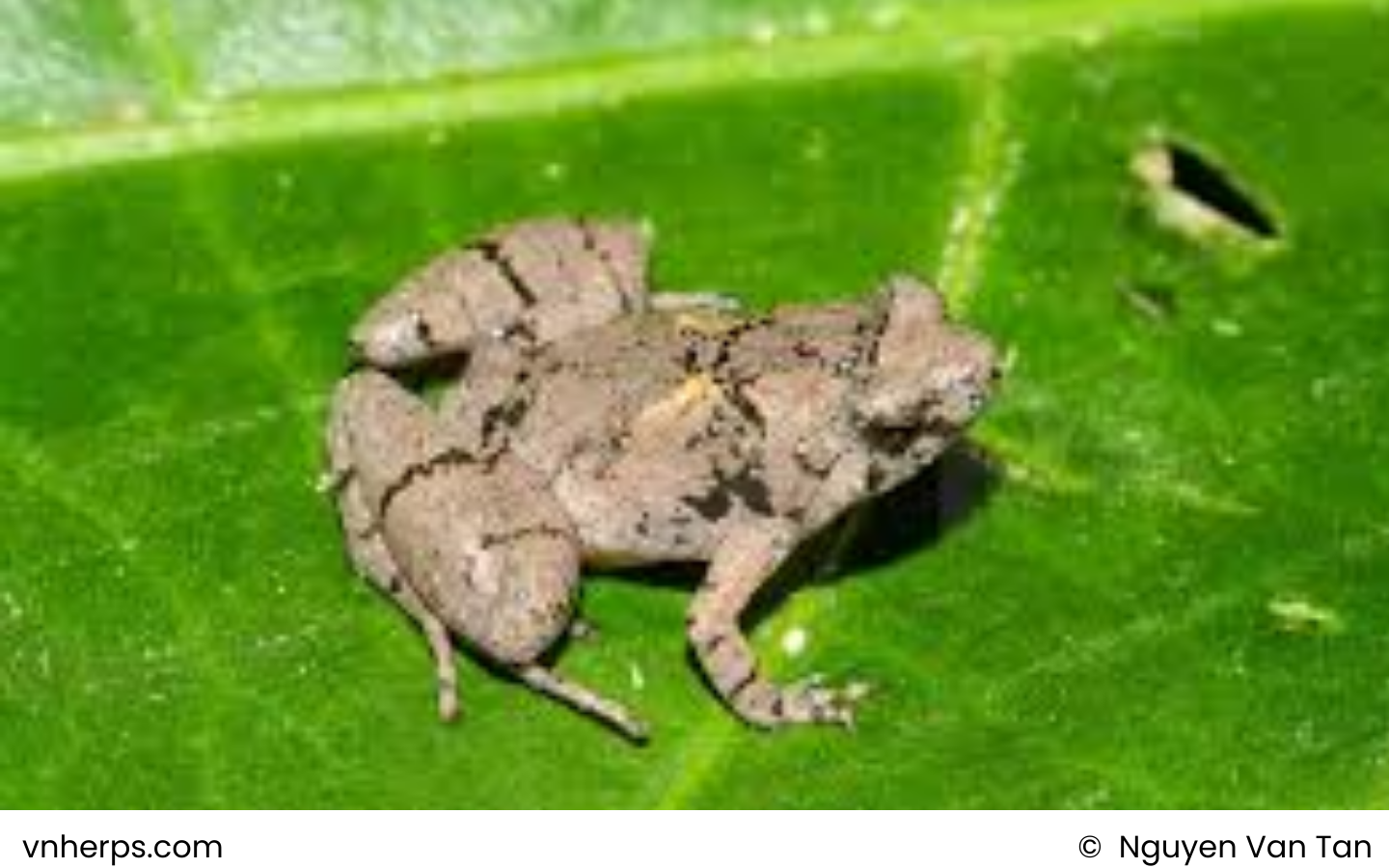
Science name: Microhyla minuta – Poyarkov, Vassilieva, Orlov, Galoyan, Tran, Le, Kretova & Geissler, 2014
Taxonomic: Animalia>> Chordata>> Amphibia>> Anura >> Microhylidae >> minuta
Species status: Endemic ; IUCN status: LC (Least Concern)
Description:
Physical Characteristics: Microhyla minuta is a small-sized frog, with males reaching a snout-vent length (SVL) of 14.7–15.9 mm and females slightly larger at 15.7–17.2 mm. The species has a slender body with slightly granular or pustular skin on the dorsum. Its head is triangular with a bluntly rounded snout, and both fingers and toes are weakly dilated with small disks. Finger and toe disks have median longitudinal grooves, which appear as shallow notches on the tips.
Coloration: The dorsal surface is olive-gray or brownish, with two distinct yellow “)(”-shaped scapular marks in males. The belly is light and cream-colored, while the throat is darker and mottled. Tadpoles have a darkly pigmented body with golden spots and a long tail.
Distribution and habitat:
Altitude: Microhyla minuta is found at an elevation of 157 meters above sea level (asl).
Range: This species is known only from Cat Tien National Park, Dong Nai Province, in southern Vietnam. Similar habitats occur in adjacent lowland areas of Lam Dong, Binh Phuoc, Dak Nong, and Binh Thuan Provinces, suggesting the potential for a broader range. Additionally, it may be found in eastern Binh Duong Province, as surveys in these areas may uncover its presence.
Habitat: Microhyla minuta inhabits mixed monsoonal semi-deciduous lowland forests. The species is closely associated with temporary grassy pools formed during the wet season, where males call and breeding occurs. The species’ range and its habitats are under increasing pressure from agricultural encroachment and logging activities.
Behaviour and ecology:
Lifestyle: This species is terrestrial and can be found in dense, lowland tropical forests. Males call from the edges of temporary pools during the breeding season, which typically occurs at the end of the wet season (mid to late September). Males have been observed calling from hollows, grass leaves, or small depressions in the ground.
Reproduction: Breeding takes place during the wet season, with males congregating and calling after heavy rains. Eggs are laid in temporary pools, and tadpoles hatch about 48 hours later. Larvae feed on the water surface and continue development until metamorphosis.
Feeding: Microhyla minuta is likely insectivorous, feeding on small invertebrates, although specific dietary data for this species is not available.
Conservation and status:
IUCN Red List Category and Criteria: Microhyla minuta is listed as Data Deficient under the IUCN Red List. The last assessment was conducted in August 2020, and the species’ population trend is considered decreasing.
Threats: The primary threat to Microhyla minuta is habitat loss due to agricultural expansion, deforestation, and logging in its lowland forest habitats. These activities result in a continuing decline in the quality and area of suitable habitat for the species.
Conservation Actions: No specific conservation measures are currently in place for Microhyla minuta. However, its range includes Cat Tien National Park, a protected area, which may provide some degree of protection. Further research is needed to better understand the species’ population size, distribution, and ecological requirements to inform conservation efforts.
Crocodile Trail – The Best Birding Trail in Cat Tien National Park
If you’re a birder or nature photographer planning a trip to Vietnam, few places offer [...]
Cong Troi Trail – Top 1 Dalat Plateau Birding Trail Experience
If you’re a birder or nature photographer planning a trip to Vietnam’s Central Highlands, the [...]
How to Identify the Greater Sand Plover, Tibetan Sand Plover and Siberian Sand Plover
Identification Differences within the Sand Plover Complex: The sand plover group, which was traditionally divided [...]
Highlights of Cat Tien National Park Reptiles and Amphibian Endemics
Spanning over 71,350 hectares of tropical forests, grasslands, and wetlands, Cat Tien National Park is [...]
Highlights of Cat Tien National Park Mammals in a World Biosphere Reserve
In addition to reptiles and birds, Cat Tien National Park is also rich in mammals, [...]
Kontum Plateau Endemic and Highlight bird
Kontum Plateau Endemic And Highlight Bird species like Chestnut-eared Laughingthrush and top birding routes while [...]